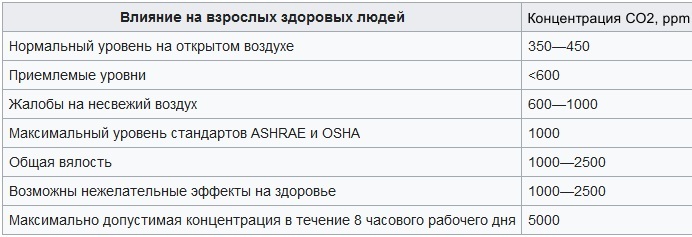Content
- What is myopathy, how does the disease proceed
- Causes of development, predisposing factors
- Symptoms of the disease
- Diagnostics
- Can myopathy be completely cured?
- Treatment methods, schemes
- Medicines
- Vitamins
- Nutrition for muscle atrophy
- Physiotherapy
- Physiotherapy
- Massage
- Psychotherapy
- Folk remedies
- Video about myopathy
Several decades ago, myopathy was considered incurable. Modern methods of treatment have made it possible to slow down the development of symptoms and, in some cases, stop the progression of the disease, and improve physical activity.
What is myopathy, how does the disease proceed
In medicine, this term is used collectively to refer to various diseases that are primarily associated with muscle weakness and degeneration.
Myopathy (symptoms and treatment are determined by a neurologist) often affects skeletal muscles. The disorder occurs under the influence of changes in the synthesis of nucleic acids, acceleration of the breakdown of proteins, an increase in the content of creatine phosphokinase, and a decrease in the level of ATP. In myopathy, part of the muscle fibers is replaced by adipose tissue, the muscles become thinner, and their atrophy occurs.

Symptoms of myopathy rarely occur in the muscles of the cardiovascular system. But if this happens, doctors talk about cardiomyopathy. Depending on the type and severity of myopathy, it leads to limited motility, both large and small, which has a negative impact on the quality of life. The disease can be congenital or primary and acquired or secondary.
There are 4 types of primary myopathies:
-
Muscular dystrophy. These are hereditary diseases that are characterized by progressive muscle breakdown. The most common forms are Duchenne myopathy and Becker-Keener muscular dystrophy.

- Myotonic syndromes. This group is characterized by prolonged muscle tension. These include Thomsen's congenital myotonia or type 1 myotonic dystrophy.
- Congenital myopathies. The disease leads to muscle weakness immediately after birth. Typical representatives of this group are Brodie's disease and myotubular myopathy. The classic age of manifestation is the neonatal period, but milder forms can appear at any age.
- Mitochondrial myopathies. The disease develops under the influence of disturbances in the energy metabolism of cellular components called mitochondria.
Secondary myopathy cannot be classified as an independent disease; it is a symptom of the underlying disease. For example, myopathies can occur with an underactive thyroid gland or vitamin D deficiency.
Types of secondary myopathies:
| Views | Causes | Symptoms | Prevalence |
| Steroid | An excess of exogenous corticosteroid may result from steroid treatment for asthma, chronic obstructive diseases of the lungs and inflammatory processes such as polymyositis, connective tissue disorders and rheumatoid arthritis. | The painful process causes weakness in the proximal muscles of the upper and lower extremities and the flexors of the neck. | With a certain dose of steroid, women are 2 times more likely to develop muscle weakness than men, although the cause is unclear. |
| Endocrine | Endocrine myopathies are not inherited and result from abnormal activity of the thyroid gland. | Patients with endocrine dysfunction often complain of vague fatigue and weakness. | Hyperparathyroid myopathy - the peak incidence occurs at 40-60 years. Hyperthyroid myopathy - the peak incidence occurs in 20-60 years. Hypothyroid myopathy - the risk of morbidity increases after 40 years. |
| Alcoholic | Skeletal muscle dysfunction is common in patients with alcohol use disorder, since alcohol adversely affects both anabolic and catabolic pathways for maintaining muscle masses. | Clinically acute alcoholic myopathy is characterized by weakness, tenderness, and swelling of the affected muscles. A common manifestation of acute alcoholic myopathy is the destruction of muscle tissue and the release of muscle fiber contents into the blood (eg, rhabdomyolysis). Chronic alcoholic myopathy is manifested by progressive weakness of the proximal muscles over several weeks or months. |
It develops in chronic alcoholics. |
| Toxic | A diverse group of muscle diseases caused by drugs and toxins, such as drugs that lower cholesterol levels. | The gradual onset of weakness over a period of weeks or months, often after starting a new medication. Difficulty getting up from a low chair or weakness in the arms when combing hair, difficulty swallowing (dysphagia) muscle pain. |
Men and women of any age can develop toxic myopathy. |
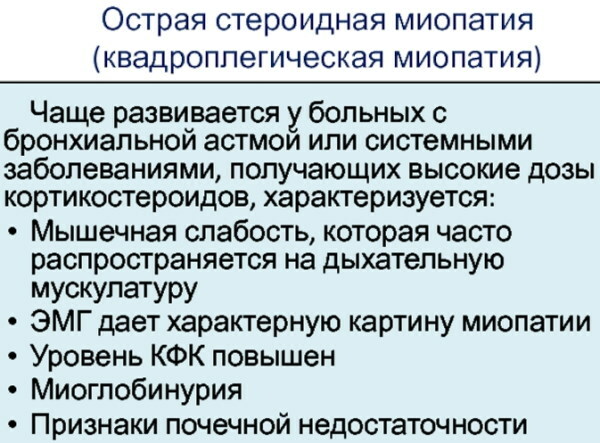
Since myopathy is often hereditary, the disease manifests itself in childhood and adolescence, mainly in men.
With myopathy, gait is disturbed, a person walks with lowered shoulders, which, as a rule, causes a curvature of the spine. Since the disease is considered progressive, the patient's condition can worsen significantly without appropriate therapy.
Causes of development, predisposing factors
Congenital myopathy (symptoms and treatment are always individual) belongs to a group of rare muscle diseases, the causes of which are based on hereditary pathological processes in the context of the protein supply of muscle fibers.
Genetic misinformation causes abnormal deposition or binding of various proteins in muscle cells. In the course of human genetic studies, scientists were able to determine the interaction of several genes that leads to structural abnormalities within muscle cells.
Secondary myopathy is caused by an underlying medical condition or other causes. For example, a malfunction of the thyroid gland, excessive or insufficient functioning of the cortex adrenal glands or significant nutritional deficiencies may be the cause of the development of secondary myopathy.
Metabolic and mitochondrial myopathies develop as a result of metabolic disorders. In the presence of these diseases, muscle cells cannot process energy sources such as proteins, carbohydrates and fats from food. This leads to a chronic lack of nutrients in the affected tissue, respectively, reduced efficiency, increased fatigue of muscle fibers.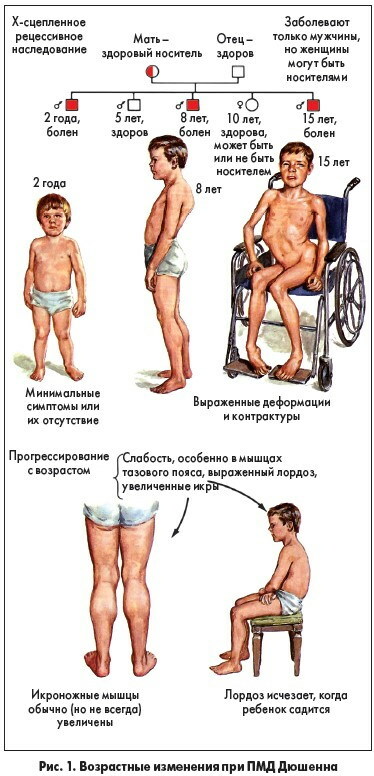
Inflammatory myopathies are based on overreactions of the immune system that lead to chronic inflammation and, as a result, to the destruction of muscle tissue. These disorders are referred to as autoimmune diseases. The reasons for the malfunctioning of the immune system often remain unknown. Inflammatory myopathies occur when the body's immune system causes inflammation in the muscles. The process can be caused by drugs or environmental toxins.
There are 3 types of inflammatory myopathy:
- Polymyositis.
- Dermatomyosi.
- Myositis with inclusion bodies.
Inflammatory myopathies are chronic or persistent conditions. They are not life threatening, but their symptoms must be treated throughout life.
Infectious myopathies are caused by viruses, bacteria, or parasites. Muscles can also be affected by systemic diseases, including connective tissue diseases and endocrinopathies.
Symptoms of the disease
Most myopathies begin with weakness in the organs closer to the trunk, especially in the shoulders, hips, and neck. But the primary symptoms become noticeable when the arms and legs are weakened. Most people find it difficult to climb stairs, brush their teeth, or brush their hair when the muscles in their arms are involved. Sometimes myopathies cause pain in these areas, and some types of diseases are accompanied by a rash.
Myopathy, the symptoms and treatment of which are determined by a neurologist with the help of a medical examination, is expressed by fatigue when walking, when it becomes more and more difficult for people to overcome long distances. Further, muscle atrophy joins the growing weakness, and later the limbs are deformed.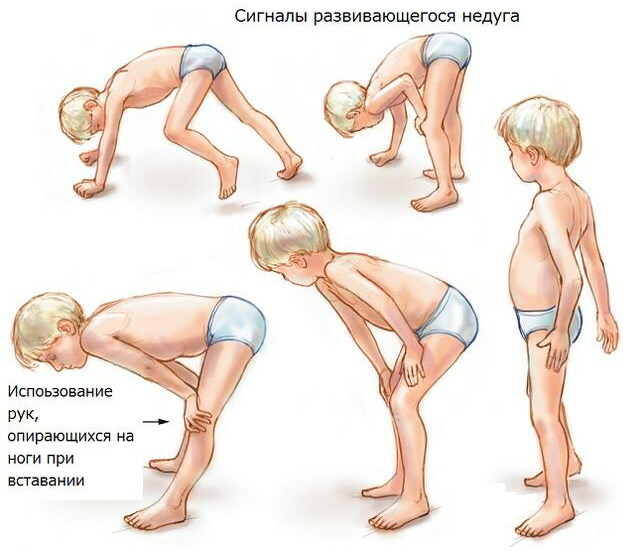
The characteristic appearance of a patient with myopathy is gradually formed:
- pterygoid scapula;
- drooping shoulders;
- bulging forward of the abdomen and increased lumbar lordosis, due to which the so-called "wasp waist" is formed;
- often there is a "duck gait" (movement is accompanied by swaying to the sides).

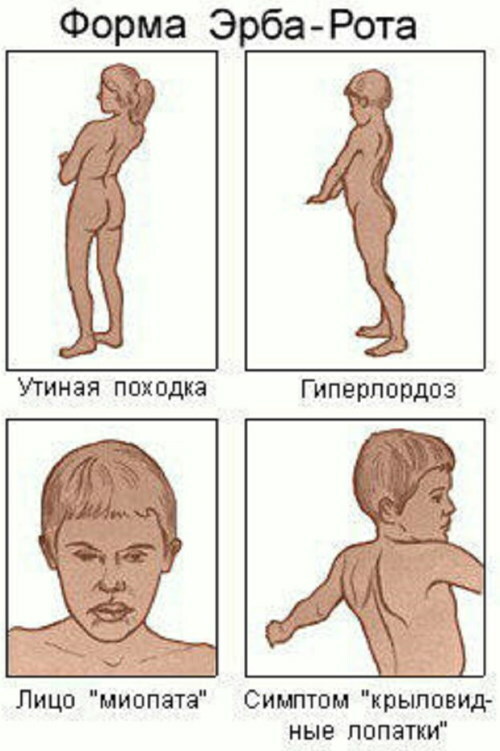
Myopathies can be accompanied by damage to the facial muscles. This is expressed in the fact that a person cannot stretch his lips into a tube, puff out his cheeks, frown or smile. The defeat of the respiratory muscles is accompanied by impaired ventilation of the lungs, which leads to congestive pneumonia. This form of pneumonia is one of the most severe downstream, difficult to treat, and rapidly leads to respiratory failure.
Diagnostics
To diagnose inflammatory myopathy, a doctor takes a close look at the medical history, performs a physical exam, and tests muscle strength.
Laboratory tests used to assess the health of patients with myopathies find out levels of:
- creatine kinase (CK) with isoenzymes;
- electrolytes, calcium and magnesium;
- myoglobin in serum;
- serum creatinine and blood urea nitrogen;
- aspartate aminotransferase.
Analytical data are examined:
- urine for myoglobinuria;
- blood;
- erythrocyte sedimentation rate;
- functionality of the thyroid gland.

Other studies include:
- ECG (nerve electrical impulses are measured);
- antinuclear antibody levels;
- genetic testing;
- electromyography;
- MRI (to assess complications or exclude neurological diseases);
- muscle biopsy.
Can myopathy be completely cured?
The prognosis for people with myopathy is different. Some have a normal life expectancy and hardly ever become disabled. In others, the disease can be progressive, leading to severe disability.
Morbidity and mortality from myopathies depend on the etiology of the condition, the severity of the disease and the presence of concomitant diseases. Severe weakness can lead to respiratory failure and death.
Treatment methods, schemes
In the case of primary myopathy, causal treatment is not possible. The goal of treatment is to minimize the effects of muscle weakness for as long as possible.
Secondary myopathy involves the treatment of the underlying disease. For example, patients who have a symptom of an underactive thyroid gland receive hormones thyroid gland, and in the case of a deficiency of vitamins or minerals, the doctor prescribes a replacement drugs.
Treatment of myopathy depends on its etiology and includes methods of supportive and symptomatic therapy, as well as therapy for specific conditions:
- Supportive therapy: management of airway patency, blood circulation, in some cases, intensive care may be required.
- Drug therapy.
- Physiotherapy.
- Strengthening techniques.
- Operation.
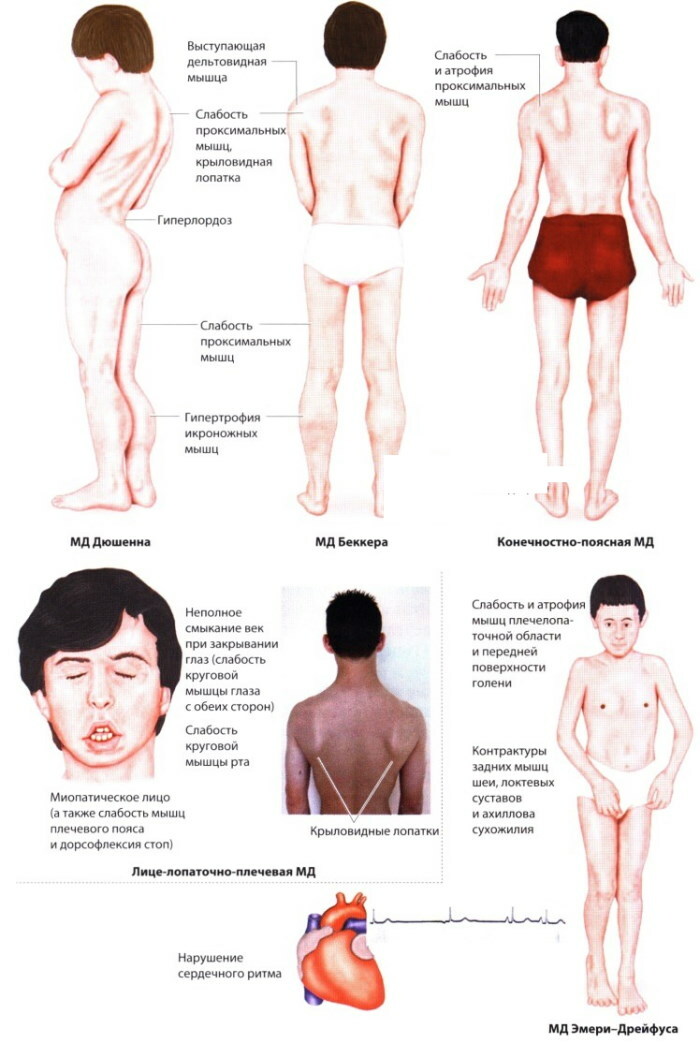
Myopathy
Most treatment plans for inflammatory myopathies include drugs that reduce inflammation and slow muscle loss.
In acute conditions such as muscle spasms, techniques are used to stabilize electrolyte balance, increase hydration, and reduce inflammation (such as ice therapy). It may also require immobilization, rest, or anti-inflammatory drugs.
Medicines
If muscle weakness affects not only skeletal but also heart muscles, patients are prescribed drugs to treat cardiac arrhythmias, such as Mexiletin or Phenytoin. If necessary, the patient is implanted with a pacemaker.
With polymyositis and dermatomyositis, the following are prescribed:
- Corticosteroids. Drugs that suppress inflammation are taken orally in the form of tablets or injected intravenously.
- Immunosuppressants Medications reduce the ability of the immune system to attack the body and cause inflammation. The types of immunosuppressive drugs prescribed depend on the severity of the inflammation.
- Intravenous immunoglobulin. Plasma-derived antibodies are used to treat people with inflammatory myopathies. Intravenous therapy is carried out daily for 5 days, followed by 3-day courses every month. Treatment may take several months.
Vitamins
For muscle fatigue, vitamins and supplements are prescribed to help combat the effects of the disorder:
-
Vitamin D, the lack of which negatively affects energy production.

- Creatine. When consumed, the body converts it into phosphocreatine, which is then stored in the muscles and used as energy.
- L-arginine. One of the 20 amino acids, the building blocks of protein, is therapeutically useful for patients with mitochondrial myopathy.
- Riboflavin (vitamin B2). Supports normal metabolism and provides the body with energy.
- Branched chain amino acids. By taking the supplement, it is possible to reduce the sensation of muscle pain and fatigue.
- Vitamins C and E act as antioxidants, have a positive effect on muscle performance and overall energy levels.
Nutrition for muscle atrophy
An anti-inflammatory meal plan (sometimes called the Mediterranean diet) can be of great benefit to those with autoimmune disease.
Basic nutritional rules:
- Avoid processed foods and fast foods, including those high in fructose, artificial ingredients, preservatives, and pesticides. Instead, choose fresh fruits, vegetables, and unrefined foods.
- Reduce the amount of foods made with wheat flour and sugar, especially breads, pasta, and most ready-to-eat snacks. Instead, use whole grains.
- Reduce consumption of saturated fats, use animal fats and products made from palm kernel oil.
- Add extra virgin olive oil, as well as rapeseed, sunflower and safflower oil to the diet.
- Include avocados and nuts on the menu, especially walnuts, cashews, almonds, and nut butter made from these nuts.
- Increase the amount of omega-3 fatty acids in your diet by eating salmon, sardines, herring, eggs, hemp and flax seeds, or taking fish oil supplements.
- Eat more plant-based protein, especially from beans and soy, and choose fish, cheese, and yogurt more often than animal proteins.
- Avoid carbonated drinks and opt for tea over coffee.
- From alcohol, give preference to red wine.
Physiotherapy
Myopathy (symptoms and treatment require examination and consultation with a doctor) is a condition characterized by muscle fatigue, therefore supportive physical procedures are necessary
Methods that improve the chemical processes in the body necessary to maintain life:
- infrared therapy;
- electrophoresis and phonophoresis with the use of metabolic stimulants;
- laser therapy;
- oxygen, aromatic baths:
- massage.
Therapeutic methods that have a vasodilating effect:
- local barotherapy;
- ultratonotherapy;
- drug electrophoresis.

Muscle nourishing treatments:
- UV therapy;
- low-frequency magnetotherapy;
- diadynamic therapy;
- treatment with ionized air.
Physiotherapy
Because most myopathic conditions are characterized by muscle weakness, strength training is an important part of exercise therapy. Classes are conducted with acceptable intensity, strength exercises should be difficult, but not painful.
Exercises such as flexion, extension, adduction, and abduction are beneficial for the legs and hips. For the back and abs, you can do abdominal crunches and connecting exercises. Classes begin with one approach of 10-15 repetitions and increase the number of approaches to 3, when the muscles are a little stronger. The key to resistance training is to take your time and listen to your body.
Exercise programs should be tailored to the individual's abilities and include:
- Training for balance, coordination and dexterity.
- Building aerobic endurance through swimming, dancing, tai chi (also good for balance training) and with equipment such as elliptical trainers, hand bicycles.
- Strength training includes resistance exercises.
- Exercises to strengthen the arms (squeeze or grip), functional exercises (training while sitting and standing, lifting weights on multilevel racks), strength equipment and wrist wraps.
- Stretching and flexibility exercises based on muscle lengthening.
- Respiratory exercises to restore diaphragmatic breathing in various positions: effectively use movements during exercise, transitions from bed to chair, in everyday activities.
- Gait training to learn to use assistive devices and demonstrate correct movement. The physical therapist should help minimize gait deviations to such an extent that the patient can walk as independently as possible.
Massage
In most cases, massage is indicated for myopathy, but its application depends on what is causing the muscle disease. If it is caused by a genetic disorder such as Duchenne muscular dystrophy, massage will improve muscle function but will not cure the disease.
Standard massage is not quite suitable for the treatment of myopathy; exercises are selected and dosed according to each patient.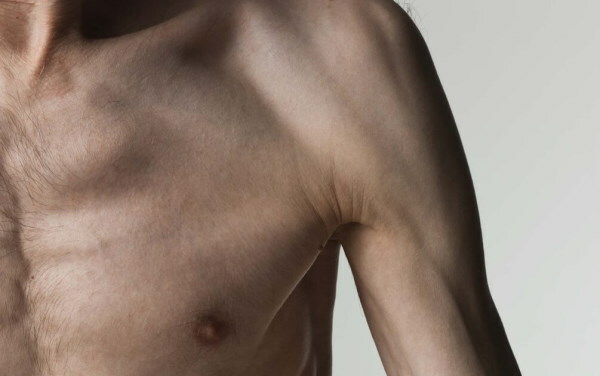
The duration of the massage is 40-60 minutes daily. The course consists of an average of 15 procedures with a regularity of 1-1.5 months.
Psychotherapy
Myopathy (symptoms and treatment can be different at each stage), like other diseases, can predispose people to mental disorders. This is in part because many diseases are associated with abnormal levels of neurotransmitters and hormones that affect mental health. Any condition that causes widespread inflammation increases the risk of depression because depression is associated with inflammation in the brain.
The neurologist and psychotherapist should work together whenever possible and coordinate patient care. Treatment may include modifying or adding medications, and using cognitive-behavioral therapy or other talking therapies. Methods for reducing and managing stress are also helpful.
Folk remedies
In alternative medicine, various measures for the sparing treatment of myopathies have proven successful. Muscle pain can be effectively reduced with herbal baths, heat and wet apple cider vinegar compresses. Among the herbs, extracts of thyme, chamomile, rosemary, mountain pine and camphor are considered pain relievers.
Patients are advised to regularly include in the menu nettle, garlic, ginger and horseradish, flaxseed oil and oily sea fish - these products have anti-inflammatory properties.
Regular cleansing of the body with natural micronized zeolite is a complex measure to rid the body of toxins that can be trigger factors for acquired myopathy. To do this, dissolve the powder in a glass of lemon water and take it daily for a month.
Muscle weakness is a characteristic symptom of all myopathies. The earlier they turn to a doctor about a disease, the better the course of the disease goes, therefore early diagnosis comes to the fore. The success of treatment largely depends on the person: his lifestyle, diet, sleep and rest.
Video about myopathy
Myopathy of Bethlem and Ulrich:


